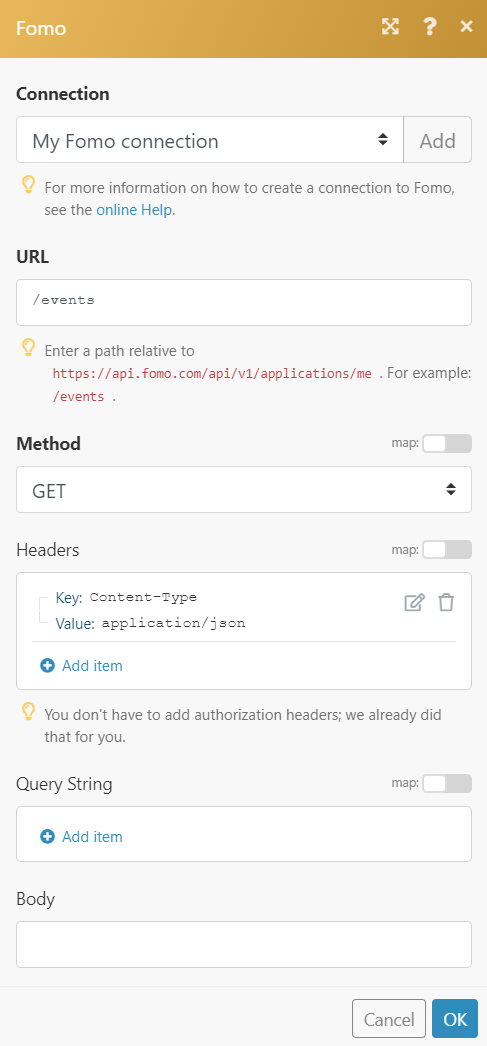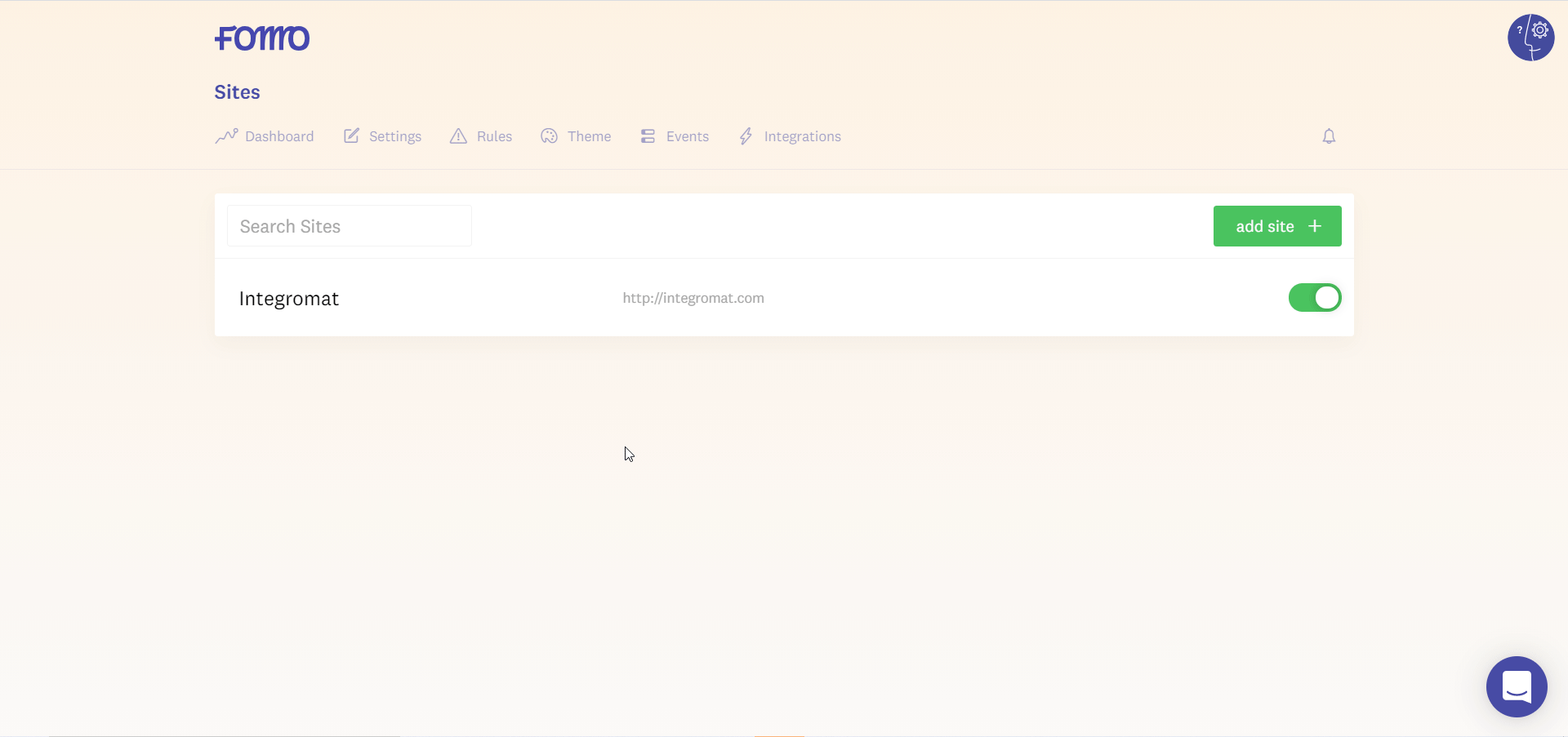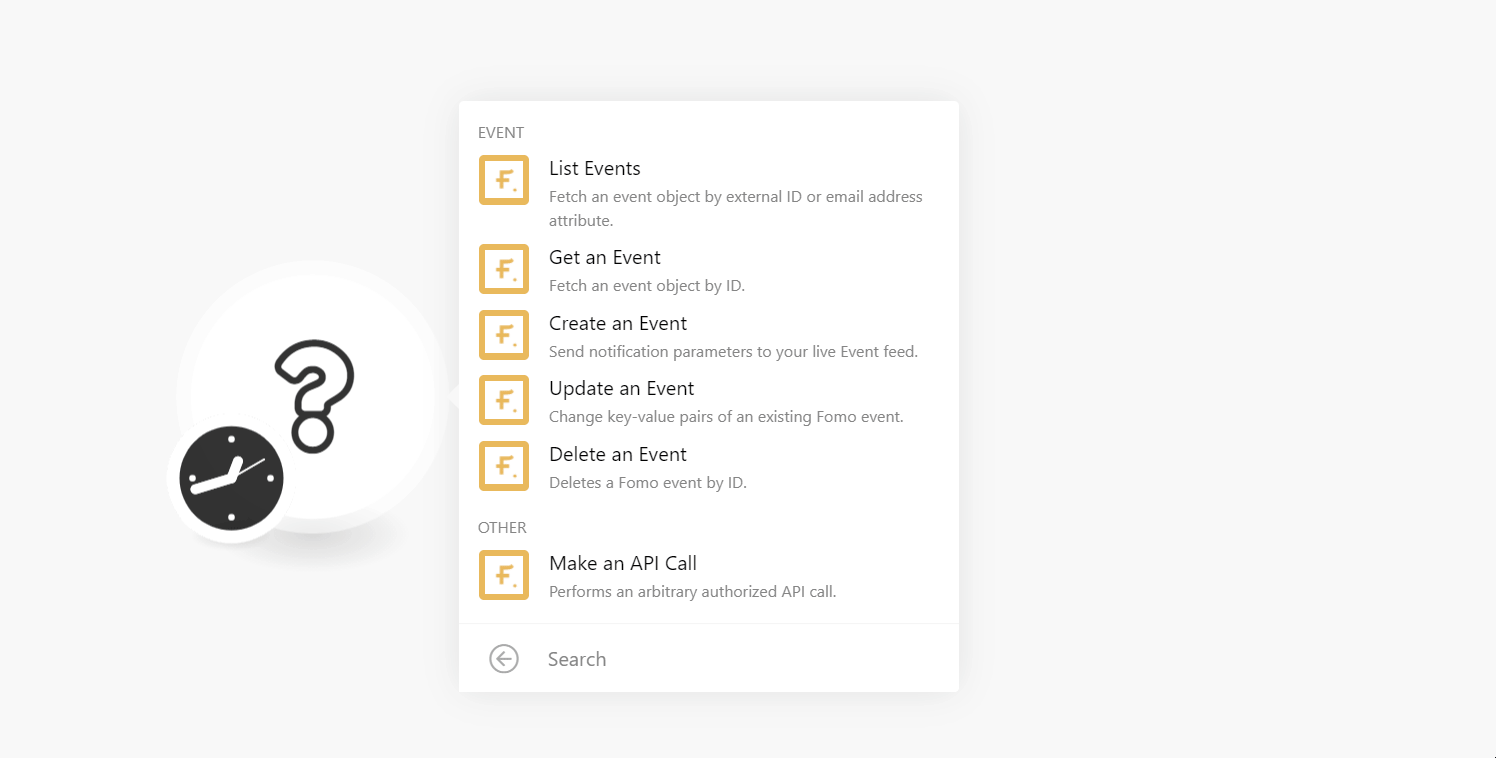| Active with remarks |
|---|
| This application needs additional settings. Please follow the documentation below to create your own connectionUnique, active service acces point to a network. There are different types of connections (API key, Oauth…). More. |
The Fomo modulesThe module is an application or tool within the Boost.space system. The entire system is built on this concept of modularity. (module - Contacts) More allow you to create, update, list, retrieve, and delete the events in your Fomo account.
Prerequisites
-
A Fomo account
In order to use Fomo with Boost.spaceCentralization and synchronization platform, where you can organize and manage your data. More IntegratorPart of the Boost.space system, where you can create your connections and automate your processes. More, it is necessary to have a Fomo account. If you do not have one, you can create a Fomo account at fomo.com/register.
![[Note]](https://docs.boost.space/wp-content/themes/bsdocs/docs-parser/HTML/css/image/note.png) |
Note |
|---|---|
|
The moduleThe module is an application or tool within the Boost.space system. The entire system is built on this concept of modularity. (module - Contacts) More dialog fields that are displayed in bold (in the Boost.space Integrator scenarioA specific connection between applications in which data can be transferred. Two types of scenarios: active/inactive. More, not in this documentation article) are mandatory! |
To connect your Fomo account to Boost.space Integrator you need to obtain the API Key from your Fomo account and insert it in the Create a connection dialog in the Boost.space Integrator module.
-
Log in to your Fomo account.
-
Click the site for which you want to establish the connection > Settings.
-
Navigate to the Auth TokenThe API token is a multi-digit code that allows a user to authenticate with cloud applications. More section and copy the token to your clipboard.
-
Go to Boost.space Integrator and open the Fomo module’s Create a connection dialog.
-
In the Connection name field, enter a name for the connection.
-
In the Token field, enter the auth token copied in step 3, and click Continue.
The connection has been established.
Fetch an event object by external ID or email address attribute.
|
Connection |
|
|
Limit |
Set the maximum number of events Boost.space Integrator will return during one scenario execution cycleA cycle is the operation and commit/rollback phases of scenario execution. A scenario may have one or more cycles (one is the default).. |
|
Order By |
Select whether you want to sort the events by created at or by Event Type ID. |
|
Order Direction |
Select the direction in which you want to list the events. For example, Asc for ascending and Desc for descending. |
Fetch an event object by ID.
|
Connection |
|
|
Event |
Select or map the event whose details you want to retrieve. |
Send notification parameters to your live Event feed.
|
Connection |
|
|
TemplateTemplates are predefined scenarios that you can expand and customize to create new scenarios. You can then share these with friends and colleagues. More |
Select or map the template for the event you want to create. |
|
External ID |
Enter (map) the event’s External ID. |
|
First Name |
Enter (map) the person’s first name who is associated with the event. |
|
Email Address |
Enter (map) the person’s first name who is associated with the event. The email address is used to create dynamic customer avatars. The email address is never shown publicly. |
|
IP Address |
Enter (map) the person’s IP address. This information is used to extract city, province, and country parameters. |
|
City |
Enter (map) the city name where the event happened. |
|
Province |
Enter (map) the state or province where the event happened. |
|
Country |
Enter (map) the two-character country code where the event happened. For example, the US for the United States. |
|
Title |
Enter (map) the event name. For example, |
|
URL |
Enter (map) the URL address to redirect the userCan use the system on a limited basis based on the rights assigned by the admin. More when they click the event. |
|
Image URL |
Enter (map) the URL address of the image to be displayed for the event. |
|
Custom Event Fields Attributes |
Enter the customer event fields and their values. For example, |
Change key-value pairs of an existing Fomo event.
|
Connection |
|
|
Event ID |
Select or map the Event ID whose details you want to update. |
|
Template |
Select or map the template for the event you want to create. |
|
External ID |
Enter (map) the event’s External ID. |
|
First Name |
Enter (map) the person’s first name who is associated with the event. |
|
Email Address |
Enter (map) the person’s first name who is associated with the event. The email address is used to create dynamic customer avatars. Never shown publicly. |
|
IP Address |
Enter (map) the person’s IP address. This information is used to extract city, province, and country parameters. |
|
City |
Enter (map) the city name where the event happened. |
|
Province |
Enter (map) the state or province where the event happened. |
|
Country |
Enter (map) the two-character country code where the event happened. For example, the US for the United States. |
|
Title |
Enter (map) the event name. For example, |
|
URL |
Enter (map) the URL address to redirect the user when they click the event. |
|
Image URL |
Enter (map) the URL address of the image to be displayed for the event. |
|
Custom Event Fields Attributes |
Enter the customer event fields and their values. For example, |
Deletes a Fomo event by ID.
|
Connection |
|
|
Event |
Select or map the event you want to delete. |
Performs an arbitrary authorized API call.
|
Connection |
||||
|
URL |
Enter a path relative to
|
|||
|
Method |
Select the HTTP method you want to use: GET to retrieve information for an entry. POST to create a new entry. PUT to update/replace an existing entry. PATCH to make a partial entry update. DELETE to delete an entry. |
|||
|
Headers |
Enter the desired request headers. You don’t have to add authorization headers; we already did that for you. |
|||
|
Query String |
Enter the request query string. |
|||
|
Body |
Enter the body content for your API call. |
The following API call returns all the events from your Fomo account:
URL:
/events
Method:
GET

Matches of the search can be found in the module’s Output under BundleA bundle is a chunk of data and the basic unit for use with modules. A bundle consists of items, similar to how a bag may contain separate, individual items. More > Body.
In our example, 2 events were returned:



